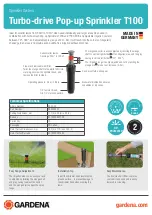
3
HARDWARE INSTALLATION
Be certain to follow standard anti-static procedures when handling any of Midian’s products.
Note:
This product should be located at the destination point for the audio and not at the source of the audio on a
dry line.
J1: Input Connector:
Connect pins J1:2 (red) and J1:3 (green) to the dedicated line coming from the audio
source.
J2: Output Connector:
Connect pins J2:2 (red) and J2:3 (green) to the dedicated line going to the destination.
PL1: Power Input:
Plug the supplied wall power adaptor into this connector. The wall power adaptor is 18 VDC
output and 110-220 VAC 50/60 Hz input.
HARDWARE ALIGNMENT
Band-Pass:
Send the unit a 700 mV p-p signal on the Input line. Monitor P4 with an Oscilloscope or Sinadder. If
using an Oscilloscope tune R-13 (15 turn potentiometer) for maximum amplitude. If using a Sinadder tune R-13
for -12 to -10 dB of sinad. Use an Oscilloscope or Frequency Counter to read the tone frequency on the output.
Notch Filter:
Send the unit a 700 mV p-p signal on the Input line. Monitor P5 with a Sinadder. Tune R-14 for -27
to -42 dB of sinad (-30 dB recommended). It may be necessary to tweak R-13 to get R-14 lower.
THEORY OF OPERATION
The NFBF-10 employs a High Q state variable filter. It also uses a 15 turn potentiometer that adjusts the
frequency based on the version ordered. The notch filter function is accomplished by summing the band-pass
audio with the incoming audio, resulting in phase cancellation at the adjusted frequency.

























